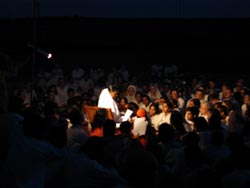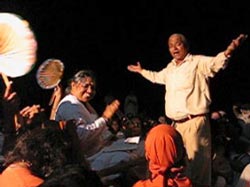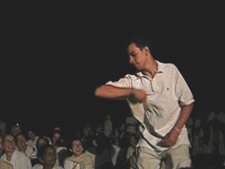Bharata Yatra 2004
Saturday, 28 February 2004 — just off NH 9, on the way to Pune, Maharashtra

The sun was gone. Amma and Her children were seated in the middle of a vast and arid plain. If it wasn’t for the occasional hum of a truck passing on the highway or the small group of cattle being slowly herded in the distance, they just as easily could have been on the moon—such was the barren, isolated feeling of that land.
Amma was singing Marathi bhajans she would sing during Her Pune programs: a namavali called “Ramakrishna Govinda Narayana Hari,” a translation of “Ishvar Tum Hi” and a new one proclaiming the glories of Lord Rama called “Mukhi Asu de Prabhu Che Nam.”
This is Maharashtra, where the Mahatma tradition is so rich, it is said there used to be a Saint in every village. So it was no surprise that when Amma’s camper crossed the state’s border, She was immediately greeted by a small group of devotees. They followed Her to the next stop, where they received Her in a way befitting a Mahatma. Now, as Amma sang the Marathi songs, She called one of those devotees to Her side, asking him to scrutinize the songs for errors of syntax. But in this land of bhaktas, criticism was not forthcoming, only a lesson to Amma’s ashram children in pure, innocent devotion—for this was the same devotee that annually does Krishna puja to Amma at her Pune ashram.

Almost since the inauguration of the Pune Brahmasthanam temple, Kale Master, now in his late sixties, has come into Amma’s arms like a modern-day gopi—a true Krishna bhakta—dressing Amma in a yellow shawl, a small crown and peacock feather, while presenting her with a wooden flute and small clay pots filled with curd and cream. It has become something of a Pune institution, the rebirth of Amma’s Krishna Bhavas of old. So, in that barren field, sitting at the feet of His Lord as She sang songs of the Vaishnava tradition, the last thing on Kale Master’s mind was Marathi grammar. He simply swayed from side to side, with an impossibly large smile on his face. Occasionally he would exclaim, “Amma is Lord Krishna! Amma’s face looks just like that of Lord Vithala!”
Soon enough, Amma began a bhajan to Lord Vithala, the Krishna deity installed in the famous nearby temple of Pandharpur. The song, “Chandra Bhaga Teere,” is full of heartfelt cries to Krishna, such as “Panduranga Hari Jai Jai! Panduranga Hari!” and the ecstatic repetition of “Vithala! Vithala! Vithala! Vithala!” As Amma become absorbed in the bhajan, Kale Master rose to his feet and, with arms held up to the sky, began to dance like a child. Amma was delighted. A loving laughter seemed just beneath the surface of Her song, but it never truly came forth. Instead, seeming to be sparked by Her son’s devotion, She extended the song’s finale for several minutes. This left the door wide open for Kale Master to break into an impromptu series of long rapturous calls to His Lord.

When the song ended, almost everyone—Amma, Her children and Kale Master—were all but out of breath. With the bhajan practice officially over, Amma started asking for questions, jokes and stories.
It was then that someone told Amma one of Her other children, an American teenager named Santosh, also had a dance for Her. Amma called out to him, and somewhat sheepishly, he came forward. Then, standing in a clearing, Santosh began to demonstrate some devotional moves of his own, albeit, a little more hip than Kale Master’s—he break danced. With everyone clapping a beat, the quiet Santosh came alive in a series of movements that had his whole body moving like one liquid whole. Just as Amma had been absorbed by the devotion of Her old man from Pune, She now starred wonder struck at the skills of Her teenager from America. “He’s doing it with so much concentration,” Amma complemented. “It’s like a meditation.”
It was getting late and there was still a long drive left before the tour group would reach the Pune ashram, but still Amma felt there was time for one question—a short one. One devotee came forward, a young man from Canada. “How do you get the maximum out of the presence of a Satguru without wasting a minute?” he asked.
Amma seemed to like the question; She gave the questioner a big thumbs up. “Live each minute with awareness,” Amma said. “The minute that you get with the Satguru—think that minute is the only minute. Live in the present. Only the present actually exists. Each thing you do, do it with full awareness. Eat with awareness, walk with awareness. That way you don’t waste any time. Like when you are playing cricket or basketball, you will not think of your girlfriend. When you are playing basketball, you will only be thinking of putting the ball in the basket. This is how it should be when in the presence of a Satguru. “
—Sakshi
